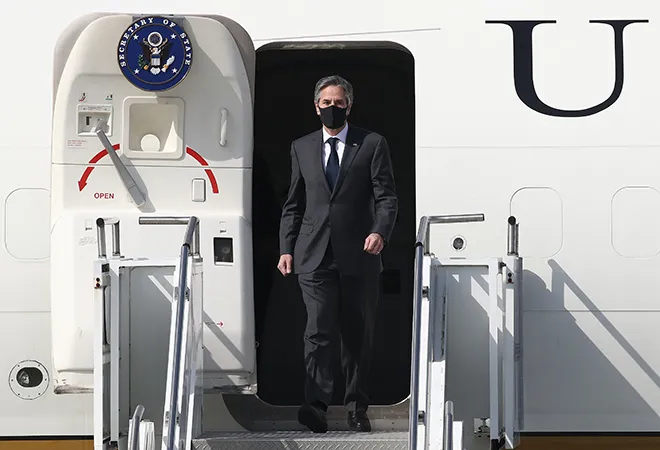
On 9 June, Russia agreed to hold talks with the US in order to negotiate the conditions to extend the New Strategic Arms Reduction Treaty (New START). The deputy foreign minister of Russia Sergei Ryabkov and US envoy Marshall Billingslea met in Vienna on 22 June, in order to discuss the treaty’s future. New START is set to expire in February 2021, and with just over seven months left to map out the future of US-Russia arms control efforts, a negotiation between the two nuclear powers is significant. The first day of the talks saw the US and Russian envoys making “guarded comments” about the outcome. Negotiators from the two countries hinted at the possibility of a second round of discussions in July or August in order to look at a nuclear pact, which would factor in the “radically different strategic environment” in 2020.
The New START, which came into force in February 2011, is the last of the remaining nuclear arms agreements between the United States and Russia which focuses on the reduction of both the US’s and Russia’s nuclear arsenals. According to New START, the two countries “must meet the Treaty’s central limits on strategic arms by 5 February, 2018; seven years from the date the Treaty entered into force. Each Party has the flexibility to determine for itself the structure of its strategic forces within the aggregate limits of the Treaty.”
New START is set to expire in February 2021, and with just over seven months left to map out the future of US-Russia arms control efforts, a negotiation between the two nuclear powers is significant.
Over the past few years, international efforts and agreements to promote arms control have taken a serious hit with Washington withdrawing from several arms control treaties, such as the Intermediate-Range Nuclear Forces (INF) treaty and more recently, the Open Skies Treaty. The Trump administration has made its stance on such treaties and agreements abundantly clear with these withdrawals. Washington continues to argue that the US stance is based on the inability of other stakeholders and signatories to accord the same level of importance to arms reduction (i.e. US used Russia’s violations for its withdrawal from the INF treaty but it has not shied away from pointing its finger at China’s massive missile build up and hence the need to include China in any future measure). Although Moscow has voiced interest unequivocally in extending the New START, Washington has been less enthusiastic. Nevertheless, US policymakers have shown interest in holding discussions with their Russian counterparts over the future of nuclear arms agreements.
However, Washington has insisted on involving China in any negotiations with Russia. This follows a pattern of the US justifying its decision to terminate its association with several arms control mechanisms. The US’s emphasis on China’s involvement in future negotiations for a new treaty has stunted the productivity of talks between Russia and US and put the arms control regime in a state of flux. Throughout this, Beijing maintained its refusal to be involved in any negotiations and instead argued that US and Russia are solely responsible for promoting arms limitations with a combined possession of over 90% of the world’s stockpile. Similarly, in the case of New START, China’s Foreign Ministry Spokeswoman Hua Chunying confirmed that Beijing was not interested in participating in nuclear disarmament negotiations with Washington and Moscow.
The US’s emphasis on China’s involvement in future negotiations for a new treaty has stunted the productivity of talks between Russia and US and put the arms control regime in a state of flux.
Moscow suggested that it was not opposed to China’s inclusion in the negotiations but did caution that the US’s insistence on the same could negatively impact the future of arms control and that it appeared “unrealistic.” Deputy foreign minister Ryabkov also suggested that if the involvement of Beijing (an ally of Russia) was on the table, the US allies who also happen to be smaller nuclear powers should be included in the negotiations. Both US and Russia have over 6,000 warheads, whereas China is estimated to have around 290 warheads. The vast divide in numbers and China’s unwillingness to engage in arms control negotiations suggests that it is unlikely that Beijing will participate in any upcoming discussions with the two.
David Sanger of The New York Times also highlights an important concern in China’s involvement in New START negotiations. Sanger argues that China’s involvement in the treaty is confusing since it limits US and Russia to 1,550 warheads each. As mentioned, China’s arsenal remains under 300 and it can be argued that “the United States and Russia would never be willing to reduce their arsenals to the 300 or so held by China. And allowing China to build up to American and Russian levels seems to defeat the purpose of arms control.”
Washington’s fixation on China’s involvement, the growing distrust between US and Russia and the collapse of several agreements do not bode well for the second round of discussions.
Given the cloud of uncertainty around the New START, observers continue to stress the importance of international disarmament measures. With the US disengaging from the international arms control regime and withdrawing from major nuclear accords like the INF treaty, the future of arms control is in a precarious state. Washington’s fixation on China’s involvement, the growing distrust between US and Russia and the collapse of several agreements do not bode well for the second round of discussions. However, this does not take away from the fact that it is crucial to continue to engage in such negotiations. It is important to reign in the growing shift towards building larger stockpiles with the demise of international agreements. The world is moving closer towards a new and more aggressive nuclear arms buildup with much larger consequences and ramifications. The increasing hostilities between stakeholders in the nuclear order demand a genuine effort from the two major nuclear powers to work towards a workable solution including extending the New START and gradually make its way to more global arms control measures.
The views expressed above belong to the author(s). ORF research and analyses now available on Telegram! Click here to access our curated content — blogs, longforms and interviews.




 PREV
PREV


